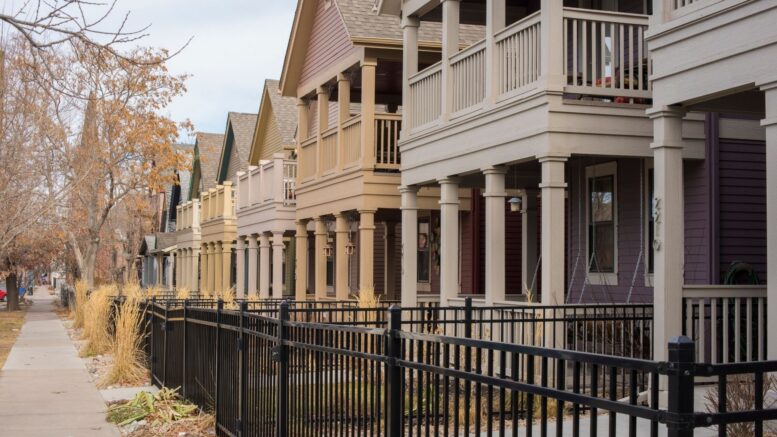Initiatives 50 and 108 would affect Colorado’s housing market directly by cutting property-tax bills. But builders and special-district leaders believe they also will have an unintended impact: Roiling the bond market and slamming the brakes on many new developments.
Initiative 50, offered for the November ballot by Advance Colorado and Colorado Concern, would cap the annual statewide increase in property-tax revenues at 4% and allow governments to collect more only if they get approval at the ballot from voters. Initiative 108 would cut residential property tax-assessment rates from 7.15% to 5.7% and reduce commercial property assessment rates from 29% to 24%, requiring the state to backfill the coffers of any local governments that see a drop in revenues because of it.
It is the provisions of Initiative 50 that worry bond dealers, developers and special-district leaders — both its hard 4% cap and its nebulous requirement that a “statewide vote” is required to exceed that cap. The reason: As written, the cap does not make exceptions for tax revenue generated by newly built properties, even as metro-district leaders and others rely on annual increases in property-tax revenue from expanding communities to repay bonds they sold to finance their communities’ residences and infrastructure.
Will provisions clash with metro districts?
A full 88% of Front Range homes built in 2023 were built within metro districts, which represent the most economically viable way to quickly construct residences and community infrastructure at a time when local governments rarely use taxpayer resources to install roads, sewer or parks in areas before new residents fill them. If metro-district home construction were to slow dramatically, it would result in a massive drop-off in overall building at a time when analysts say the state already is more than 100,000 residences short of what is needed to house its current population — and would exacerbate the existing affordability crisis.

State leaders say Colorado needs more homes, like these in a neighborhood in Westminster.
But many bonds, both for metro districts and for urban-renewal districts that aim to re-energize cities’ commercial cores, anticipate or require increases in property-tax values above 4% to repay bondholders. Restrictions on revenue that is contractually obligated to go to bond holders will result in lawsuits and market instability, warned the Colorado Municipal Bond Dealers Association and a group of eight law firms with bonding specialists in a pair of letters to initiative proponents.
Meanwhile, the question is murky, because of the “statewide vote” wording in Initiative 50, of how these districts could even seek to keep revenue above the cap if the initiative passes. Would metro-district boards, for example, be able to ask their residents, or would a developing community in Aurora have to plead to voters on the Western Slope to back their revenue-retention request?
“The complexities of Initiative 50 are such that they have a lot of ambiguities and a lot of conflict,” said Chris Elliott, president of E5X Management, which develops master-planned communities via metro-district tools like bonds. “The fact that it affects not only existing districts and the agreements that are in place, but future districts, invites a lot of litigation and creates a lot of uncertainty in terms of how those things go forward.”
Property-tax-cut proponents push back against argument
But Josh Penry, a campaign strategist for the tax-cut proposals, argued that most of the uncertainties detailed by developers and bond experts can be dealt with by the Legislature when it writes enabling legislation if Initiative 50 passes. That legislation can exempt new construction from the capped revenue and can specify that local governments can ask their voters, rather than all Colorado voters, to approve cap overrides, he said.
“The starting point for our conversation is a simple one, and that is: Property taxes have escalated at an irresponsible rate,” Penry said. “The Legislature has done as little as possible, and certainly not enough. And this issue should be decided by the voters.”
The recently signed Senate Bill 233 caps annual growth in statewide property-tax revenues for local governments at 5.5% but exempts revenue that is going to school districts and is pledged to repay bonds and other debt. It also lowers the nonresidential assessment rate to 25% and residential assessment rates to 6.95%, calculated only after residents deduct 10% of home value, up to $70,000. Critics charge it doesn’t do enough.

Gov. Jared Polis signs Senate Bill 233 in May while flanked by supporters of the legislation.
How metro districts work
Development companies that get the go-ahead from local governments to form metro districts then issue public debt, which is repaid to bond holders over periods that sometimes last 50 years from property-tax mill levies on the future residents of the district. Repayment agreements typically anticipate payments rising— often by more than 4% — in later years as the communities build out and increase in property value.
Local governments back creation of these districts because the bond-repayment structure allows developers to put in amenities such as parks and community centers at the start of building rather than to have to generate money from home sales first to repay loans. And such approvals allow for the use of public debt that exempts the bondholders from paying federal or state tax on the interest they receive, allowing them to charge lower interest rates to developers and letting those developers keep down the cost of homes, Elliott explained.
Initiative 50 would interfere with existing bond debt if property-tax revenues are capped at a level below which the bond-selling developers have pledged to repay the bond holders, the two letters to proponents argue. Carolynne White, a real-estate attorney with Brownstein Hyatt Farber Schreck, said she expects that would generate a large number of lawsuits.
Also, the impact of future trading and pricing of bonds would be “severe,” as the cap and the requirement to get voter approval to exceed it would introduce a significant new risk factor that many bondholders may not want to assume, the letter from the law firms read. Elliott said he’s already seen the two major bond buyers domiciled in Colorado pulling back on what debt they will purchase from within the state, and he expects nationwide firms either will join that boycott or increase interest rates greatly if Initiative 50 passes.
“Uncertainty” could prevail under property-tax cut
Penry, a former Colorado Senate minority leader who ran bills that dealt with bonding, argued that the potential for lawsuits is overstated because bond covenants specifically state that they must follow the laws of Colorado, which are subject to change. And while he understands that bond buyers anticipate increases in property-tax revenue, there must be curbs on the massive increases in taxes Coloradans experienced in recent years.
“A 40% property-tax increase on top of a 10% property-tax increase on top of an 8% property-tax increase is unsustainable,” he said. “So, we’re wrestling here with two different public-policy questions.”
Elliott said, however, that if bond buyers give up on Colorado, builders likely would have to borrow money from banks, which would come with higher interest rates and shorter repayment periods, forcing them to build residences first and consider community amenities only later. He estimated that, in combination with the loss of tax breaks that come with public debt, could increase the cost of residences by 30% to 50%, putting home ownership even further out of reach for many people.
That in turn would lead to a significant downturn in the number of homes that would go up in Colorado, as builders with multi-state presences likely would seek the path of least resistance and construct in other states, the letter from the law firms said. The bond market likely wouldn’t be restored until the flood of litigation is resolved, meaning that the slowdown in construction could continue for many years.
“The uncertainty around implementation of measures is really the biggest issue for us,” said Zach Bishop, head of the special-district group at Piper Sandler. “Catching up existing debt in this and creating uncertainty about how this works going forward is the challenge. And it’s a challenge for government in Colorado.”
Property-tax cap could affect other districts
But the impacts of a 4% cap and requirement to go to voters to exceed it would extend far beyond special districts and homebuilding. CMBDA estimates there is currently more than $22.8 billion in outstanding public debt funding everything from new school buildings to fire stations to water-treatment plants that could be affected by Initiative 50.
White noted there are about 60 active urban renewal authorities with a combined 160 projects whose stated purpose is to revitalize blighted areas by attracting private investment that will boost the property values of an area. Many of them anticipate biannual property-tax revenue increases of 10% or more because they are working to “goose the economy” in those areas, and the debt they sell impacts a number of commercial buildings located within those districts, White said.
If Initiative 50 were to pass, there also is a question of how URAs into which five to 10 local governments — cities, counties, school districts and special districts — have committed portions of tax revenue will seek to retain that money if the growth exceeds 4%. What would happen, White asked, if some local governments approved the tax rates exceeding the cap and others did not? Would that leave revenues short of repaying debt contracts? Would some governments essentially become free riders, getting the benefit of the improvements without having to chip in the same percentage of tax revenues?
Ann Terry, executive director of the Special District Association, said bonding is a common tool for the roughly 3,800 special districts in the state. In addition to metro districts, her members include library districts, fire districts, hospital districts, water districts and others that build infrastructure.
Impact on economic development?
Limiting the revenue such districts can collect could limit library hours, curtail ambulance services and make it difficult to build infrastructure — all things that make communities less attractive, Terry said. Thus, she believes Initiative 50 could hurt Colorado economic development by making the state a less attractive place to live.
“If you’re a company looking to come into Colorado, aren’t you going to be looking for a safe community and a community that has good response times?” she asked. “It’s not just one area that’s going to be impacted. It’s going to be everything.”
Hearing such arguments, Penry emphasized that the future 4% annual property-tax revenue growth cap will be on top of a record property-tax revenue base that cities, counties and special districts collected after the reassessments of 2022. And he returned to his argument that the Legislature can add new-construction exemptions and clarifications about elections in enabling legislation if it’s so worried about revenues.

Advance Colorado President Michael Fields poses with boxes of signatures that he turned in on July 23 to get Initiative 108 on the ballot.
The question of enabling legislation
But other observers are skeptical that legislators have that much latitude with enabling legislation.
White, for example, noted that the Taxpayer’s Bill of Rights specifically allows for governments to keep more tax revenue annually based upon growth, while Initiative 50 does not. Terry said the Colorado Supreme Court has repeatedly interpreted the plain language of constitutional amendments in a narrow way, and she’s not sure that even efforts to enable local rather than statewide votes to keep revenue would be allowed.
Penry noted that TABOR has a clause specifying that judicial deference should be given rules that allow the strongest limitations on government, while Initiative 50 does not. He noted that initial efforts to include more detail about new-construction exemptions in the initiative were shot down by the state for violating the single-subject limitation on ballot questions — leading to the broad wording in its final version, which he believes is flexible.
The Colorado Secretary of State’s office has approved Initiative 50 for the November ballot. Meanwhile, proponents turned in nearly 200,000 signatures on July 23 to put Initiative 108 onto the same ballot — a total far larger than the 124,238 required under state law, though the signatures still must be verified by the Secretary of State.
